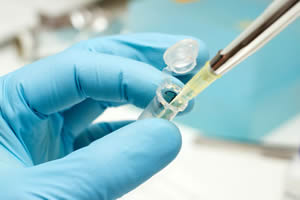
The intracytoplasmic sperm injection (ICSI) technique is a modification of classic IVF ("baby in a test
tube"). ICSI is a method where the embryologist selects a sperm and injects it into the cytoplasm of
an egg cell under a microscope. The embryo(s) are placed in the woman's uterus in the same way as
in the traditional IVF.
ICSI is usually suitable for several groups of patients, such as:
- Men with sperm parameters outside the reference limits.
- Couples with previous poor IVF fertilization outcomes.
The woman is given medication to stimulate the ovaries and develop several mature follicles. Each of
these follicles can contain an egg. Follicular development is monitored regularly with ultrasound and
blood test to ensure that drug stimulation is both safe and effective.
After obtaining mature follicles,
the eggs are retrieved using a needle under ultrasound guidance. The procedure is performed under
anesthesia. The collected eggs are transferred to a culture medium in the embryology laboratory.
The partner then provides a semen sample, which is delivered to the laboratory. The goal of the
treatment process is to obtain motile, normal-looking sperm that are injected into mature eggs.
ICSI is a delicate procedure requiring skill, experience, accurate judgment of the quality of the
selected sperm, and exceptional hand-eye coordination. It is performed by an embryologist who
works with a micromanipulator and a microscope. The mature egg is placed immobile, and the sperm
is injected into the cytoplasm with a microneedle.
The next day, the eggs are checked for signs of fertilization. Those eggs (now embryos) that have
normal fertilization develop in the laboratory for 2 to 5 days. Embryo development is monitored, and
patients are informed of their progress.
Our doctor performs the embryo transfer. Using a fine catheter, 1 to 3 embryos are introduced, depending on the circumstances and in consultation with the patient. The embryo placement procedure takes no more than half an hour.
The remaining embryos are then evaluated by the embryologist and can be frozen and stored for possible future cycles.
The first ICSI baby was born in 1992, and subsequently, many babies have been born through this technique.
